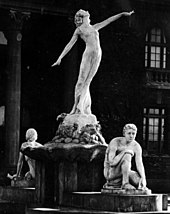Myrna Loy
She was originally typecast in exotic roles, often as a vamp or a woman of Asian descent, but her career prospects improved greatly following her portrayal of Nora Charles in The Thin Man (1934).
Loy's performances peaked in the 1940s, with films like The Thin Man Goes Home, The Best Years of Our Lives, The Bachelor and the Bobby-Soxer, and Mr. Blandings Builds His Dream House.
[8] Loy's paternal grandfather, David Thomas Williams, was Welsh, and emigrated from Liverpool, England to the United States in 1856, arriving in Philadelphia.
[11][12] During her childhood, her father worked as a banker, real estate developer, and farmland appraiser in Helena, and was the youngest man ever elected to serve in the Montana state legislature.
[15] Loy spent her early life in Radersburg, Montana, a rural mining community approximately 50 miles (80 km)[16] southeast of Helena.
Although her mother tried to persuade her husband to move to California permanently, he preferred ranch life and the three eventually returned to Montana.
[25] When her teachers objected to her extracurricular participation in theatrical arts, her mother enrolled her in Venice High School, and at 15, she began appearing in local stage productions.
[29][30] A few months later, Loy's "Inspiration" figure was temporarily removed from the sculpture group and transported aboard the battleship Nevada for a Memorial Day pageant in which "Miss Myrna Williams" participated.
After decades of exposure to the elements and vandalism, the original concrete statue was removed from display in 2002, and replaced in 2010 by a bronze duplicate paid for through an alumni-led fundraising campaign.
She obtained work at Grauman's Egyptian Theatre, where she performed in what was called prologues, elaborate musical sequences that were related to and served as preliminary entertainment before the feature film.
[34] Loy tested for the role, which went to Gertrude Olmstead instead, but soon after that she was hired as an extra for Pretty Ladies (1925), in which she and fellow newcomer Joan Crawford were among a bevy of chorus girls dangling from an elaborate chandelier.
[35] Rambova hired Loy for a small but showy role opposite Nita Naldi in What Price Beauty?, a film she was producing.
Shot in May 1925, the film remained unreleased for three years; but stills of Loy in her exotic makeup and costume appeared in Motion Picture magazine and led to a contract with Warner Bros.
It took years for her to overcome this typecasting, and as late as 1932, she was cast as a villainous Eurasian in Thirteen Women (1932) and, opposite Boris Karloff, as the depraved sadistic daughter of the title character in The Mask of Fu Manchu (1932).
At a Hollywood party, he pushed her into a swimming pool to test her reaction, and felt that her aplomb in handling the situation was exactly what he envisioned for Nora.
[39] Louis B. Mayer at first refused to allow Loy to play the part because he felt she was a dramatic actress, but Van Dyke insisted.
She and her costar William Powell proved to be a popular screen couple and appeared in 14 films together, one of the most prolific pairings in Hollywood history.
Such films as Wife vs. Secretary (1936) with Clark Gable and Jean Harlow, and Petticoat Fever (1936) with Robert Montgomery gave her opportunity to develop comedic skills.
She made four films with William Powell in close succession: Libeled Lady (1936) (which also starred Jean Harlow and Spencer Tracy); The Great Ziegfeld (1936) (in which she played Billie Burke opposite Powell's Florenz Ziegfeld); the second Thin Man film, After the Thin Man (1936) (which also starred James Stewart); and the romantic comedy Double Wedding (1937).
While working for MGM, Loy was outspoken about the studio's casting hierarchy, especially based on race, and was quoted as saying: "Why does every black person in the movies have to play a servant?
Around 1945, Loy began dating producer and screenwriter Gene Markey, who had previously been married to actresses Joan Bennett and Hedy Lamarr.
[48] Her fourth and final husband was Howland H. Sargeant, U.S. Assistant Secretary of State for Public Affairs and president of Radio Liberty,[48] whom she married on June 2, 1951, in Fort Myer, Virginia.
Loy, a lifelong Democrat, publicly supported the election of John F. Kennedy in 1960, finding Richard Nixon to be an unscrupulous man.
In January 1985 Loy was honored by the Academy of Motion Picture Arts and Sciences with a special salute held at Carnegie Hall in New York City, which she attended along with 2,800 guests.
[63] Although Loy was never nominated for an Academy Award for any single performance, after an extensive letter-writing campaign and years of lobbying by screenwriter and then–Writers Guild of America, West board member Michael Russnow, who enlisted the support of Loy's former screen colleagues and friends such as Roddy McDowall, Sidney Sheldon, Harold Russell, and many others, she received a 1991 Academy Honorary Award "for her career achievement".
Loy died at age 88 on December 14, 1993, at Lenox Hill Hospital in Manhattan during surgery following a long, unspecified illness.
[65] She had been frail and in failing health, which had resulted in her being unable to attend the 1991 Academy Awards ceremony, where she was to receive a lifetime achievement Oscar.
[72] Steel Pole Bath Tub has a song on their 1991 album Tulip that is both named after Loy and samples dialogue from one of her films ("Stinky Davis" story, excerpted from The Thin Man Goes Home, 1944).
Located in the historic Lewis and Clark Country Jail, it sponsors live performances and alternative films for underserved audiences.







